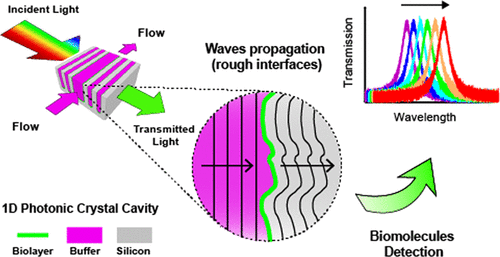Our official English website, www.x-mol.net, welcomes your feedback! (Note: you will need to create a separate account there.)
Impact of Fabrication and Bioassay Surface Roughness on the Performance of Label-Free Resonant Biosensors Based On One-Dimensional Photonic Crystal Microcavities.
ACS Sensors ( IF 8.9 ) Pub Date : 2020-08-11 , DOI: 10.1021/acssensors.0c01183 Salvatore Surdo 1, 2 , Giuseppe Barillaro 2
ACS Sensors ( IF 8.9 ) Pub Date : 2020-08-11 , DOI: 10.1021/acssensors.0c01183 Salvatore Surdo 1, 2 , Giuseppe Barillaro 2
Affiliation

|
Micro- and nanofabrication offer remarkable opportunities for the preparation of label-free biosensors exploiting optical resonances to improve sensitivity and reduce detection limit once specificity is imparted through surface biofunctionalization. Nonetheless, both surface roughness, peculiar of fabrication processes, and bioassay roughness, resulting from uneven molecular coverage of the sensing surfaces, produce light scattering and, in turn, deterioration of biosensing capabilities, especially in resonant cavities where light travels forth and back thousands to million times. Here, we present a quantitative theoretical analysis about the impact of fabrication and bioassay surface roughness on the performance of optical biosensors exploiting silicon-based, vertical one-dimensional (1D) photonic crystal resonant cavities, also taking noise sources into account. One-dimensional photonic crystal resonant cavities with different architectures and quality factors ranging from 102 to 106 are considered. The analysis points out that whereas sensitivity and linearity of the biosensors are not affected by the roughness level, either due to fabrication or bioassay, the limit of detection can be significantly degraded by both of them, depending on the quality factor of the cavity and noise level of the measurement system. The paper provides important insights into performance versus design, fabrication, and readout of biosensors based on resonant 1D photonic crystal cavities for real-setting operation.
中文翻译:

制备和生物测定表面粗糙度对基于一维光子晶体微腔的无标记共振生物传感器性能的影响。
一旦通过表面生物功能化赋予特异性,微加工和纳米加工为利用光学共振制备无标记生物传感器提供了巨大的机会,从而可以提高光学灵敏度并降低检测限。尽管如此,由于传感表面分子覆盖不均匀而导致的表面粗糙度,制造工艺特有的表面粗糙度和生物测定粗糙度都会产生光散射,进而导致生物传感能力下降,特别是在共振腔中,光会来回传播到数千倍。万次。在这里,我们提供了有关制造和生物测定表面粗糙度对利用基于硅的垂直一维(1D)光子晶体谐振腔的光学生物传感器性能的影响的定量理论分析,还考虑了噪声源。一维光子晶体谐振腔,具有不同的结构和品质因数,范围从10考虑2到10 6。分析指出,尽管生物传感器的灵敏度和线性度不受粗糙度水平的影响(无论是由于制造还是生物测定),但是根据腔体和噪声的质量因素,两者的检测极限可能会大大降低测量系统的级别。本文提供了基于共振一维光子晶体腔的生物传感器在性能,设计,制造和读出方面的重要见解,以进行实际设置操作。
更新日期:2020-09-25
中文翻译:

制备和生物测定表面粗糙度对基于一维光子晶体微腔的无标记共振生物传感器性能的影响。
一旦通过表面生物功能化赋予特异性,微加工和纳米加工为利用光学共振制备无标记生物传感器提供了巨大的机会,从而可以提高光学灵敏度并降低检测限。尽管如此,由于传感表面分子覆盖不均匀而导致的表面粗糙度,制造工艺特有的表面粗糙度和生物测定粗糙度都会产生光散射,进而导致生物传感能力下降,特别是在共振腔中,光会来回传播到数千倍。万次。在这里,我们提供了有关制造和生物测定表面粗糙度对利用基于硅的垂直一维(1D)光子晶体谐振腔的光学生物传感器性能的影响的定量理论分析,还考虑了噪声源。一维光子晶体谐振腔,具有不同的结构和品质因数,范围从10考虑2到10 6。分析指出,尽管生物传感器的灵敏度和线性度不受粗糙度水平的影响(无论是由于制造还是生物测定),但是根据腔体和噪声的质量因素,两者的检测极限可能会大大降低测量系统的级别。本文提供了基于共振一维光子晶体腔的生物传感器在性能,设计,制造和读出方面的重要见解,以进行实际设置操作。



























 京公网安备 11010802027423号
京公网安备 11010802027423号